Running an e-commerce brand in 2025 means dealing with more data, higher ad costs, and a lot more complexity. Between privacy updates, platform reporting gaps, and changing algorithms, understanding where your sales really come from has become one of the hardest parts of growth.
Choosing the right analytics and attribution platform is a strategic decision — it shapes how you understand performance and where you invest next.
Two of the most talked-about tools in this space are Triple Whale and Lebesgue: AI CMO. Both promise to help Shopify and DTC brands understand what drives sales, improve marketing efficiency, and make better decisions — but they approach this challenge in very different ways.
In this post, we’ll compare the two platforms across attribution accuracy, pricing, AI capabilities, and overall value, so you can decide which one fits your store’s goals in 2025.
While this guide is written by the team at Lebesgue, the goal is transparency — to help you see exactly where each platform shines, and where Lebesgue offers a deeper, more predictive edge.
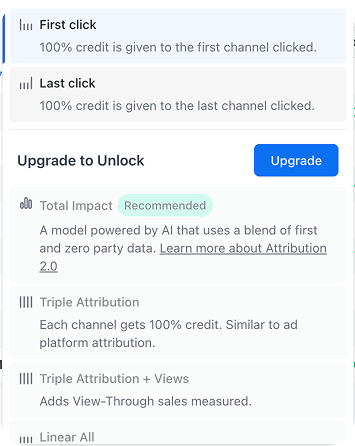
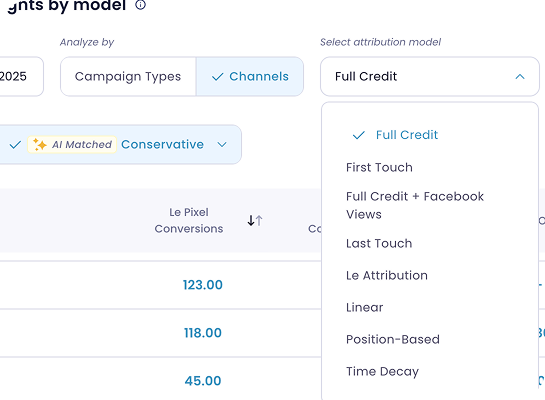
Overview of Each Platform
Modern DTC brands advertise across multiple channels — Meta, Google, TikTok, Klaviyo, and beyond. But while reach has expanded, visibility has fractured. Each ad platform tracks conversions differently, and Shopify’s native analytics often tell a conflicting story.
Add privacy updates, attribution loss, and cross-device behavior — and suddenly, understanding what’s actually driving sales becomes one of the biggest challenges for growth-focused teams.
That’s where specialized analytics and attribution platforms like Lebesgue and Triple Whale come in. Both aim to unify performance data, simplify reporting, and help you invest confidently in what truly moves the needle.
The right analytics platform should:
Combine first-party and ad platform data accurately.
Show where your revenue is really coming from.
Help you decide when and where to scale.
Lebesgue – The AI CMO for Ecommerce Growth
Lebesgue: AI CMO helps ecommerce businesses understand why performance changes — not just what happened. It connects to your Shopify, Meta, Google, Klaviyo, and Amazon accounts, offering advanced analytics powered by machine learning and competitor intelligence.
In addition, Lebesgue pinpoints key marketing mistakes happening on Facebook ads, tracks your competitors’ Meta, Google, and Email marketing to add a layer of transparency about your marketing and industry best practices.
| Lebesgue Core Features |
|---|
|
Attribution Pixel
Combines server-side and client-side data to track conversions accurately and detect which marketing channels really drive conversions.
It tracks customer interactions across the website and excels at detecting cross-device, multi-touch conversions — logging and tracking more events than any other ecommerce analytics pixel.
|
|
Attribution Models
Includes advanced, game theory, machine learning, and statistics-based attribution models for a clearer understanding of how each channel contributes to sales and ROAS.
|
|
Competitor Intelligence
Monitors ad performance, email campaigns, spend trends, and creative types across thousands of brands — allowing you to see every Facebook, Google, or email ad your competitors have published.
|
|
Creative Angles
Analyzes ad creatives to uncover high-performing patterns and suggests new creative directions based on data — helping marketers optimize visuals and messaging for stronger ROAS.
|
|
Predictive Insights
Identifies when conversion rates are likely to spike or drop and recommends when to scale budgets up or down — allowing proactive rather than reactive marketing decisions.
|
|
Henri AI
Proprietary AI technology that allows you to chat directly with an AI marketing strategist. Henri analyzes your content, ad setup, industry trends, and competitor strategies to pinpoint not just correlations — but root causes of performance changes.
|
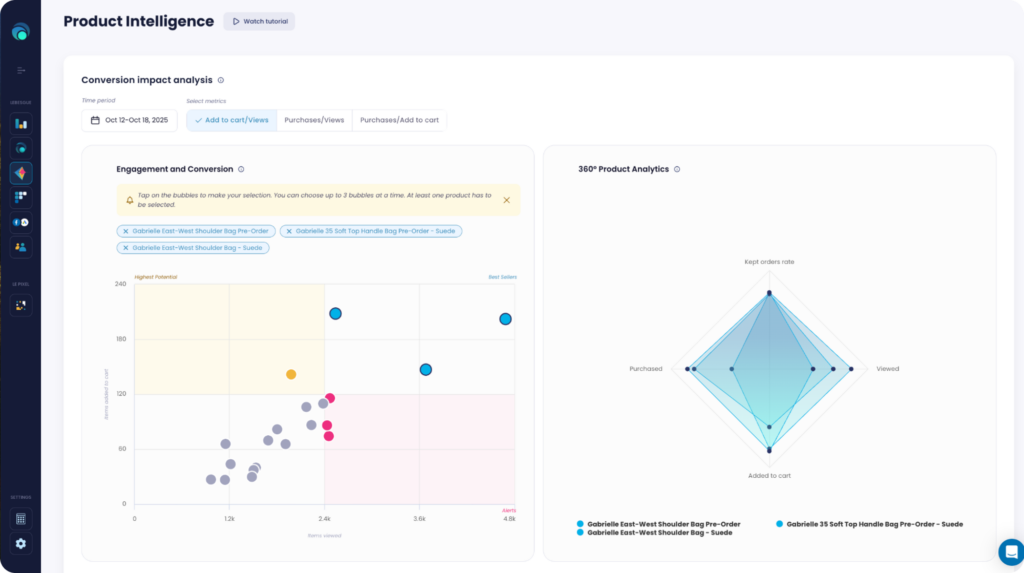
The Lebesgue AI CMO is built for e-commerce teams that want more than surface-level metrics — it’s for brands ready to understand why results shift and how to scale smarter. It’s ideal for marketers running multi-channel campaigns who rely on data-backed recommendations to guide creative and budget decisions.
Compared to Triple Whale, Lebesgue focuses less on agency-style multi-store management and more on helping individual brands drive consistent, profitable growth.
Triple Whale – Built for Shopify Attribution
Triple Whale focuses primarily on Shopify-native attribution and zero-party data. It’s built for speed and simplicity — offering real-time dashboards and clear revenue attribution across ad channels.
| Triple Whale Core Features |
|---|
|
Multi-Touch Attribution (MTA)
Tracks the customer journey across multiple ads and touchpoints, providing a simplified view of how users move from first click to purchase within the Shopify ecosystem.
|
|
Whale Dashboard
A customizable interface that centralizes profit, lifetime value (LTV), and key performance metrics, helping merchants visualize results in real time.
|
|
Post-Purchase Surveys
Collects zero-party data directly from customers after checkout to enrich attribution models and understand what influenced conversions.
|
|
Product Journeys
Maps how customers interact with individual products over time, showing which items are most likely to drive repeat purchases or act as entry points for new customers.
|
|
Integrations
Connects seamlessly with Shopify, Meta, Google Ads, Klaviyo, TikTok, and Amazon to consolidate store and ad performance in one place.
|
The Triple Whale platform is best for Shopify-first brands and marketing agencies that manage multiple stores and need fast, consolidated visibility across clients. It’s ideal for teams that prioritize clean dashboards, profit tracking, and real-time attribution without diving deep into advanced modeling or competitor analysis.
Compared to Lebesgue, Triple Whale shines in multi-store management and operational simplicity, but offers less depth in predictive analytics, competitive benchmarking, and insight — areas where Lebesgue provides a more strategic layer of intelligence.
Lebesgue vs. Triple Whale: Feature Comparison
Choosing the right analytics tool often comes down to the details — how each platform handles attribution, integrations, and actionable insights.
Below is a direct feature-by-feature comparison showing where Lebesgue and Triple Whale differ most in functionality, focus, and depth.
| Category | Lebesgue | Triple Whale | Verdict |
|---|---|---|---|
| Attribution Model | Machine learning-based, combines server-side + pixel tracking, includes game theory based attribution | Multi-Touch Attribution within Shopify ecosystem | Lebesgue for cross-channel depth |
| Competitor Intelligence | Tracks creatives, ads and email, for over 25,000 brands | Not available | Lebesgue |
| Creative Analytics | AI analyzes ad creatives and suggests new angles | Not available | Lebesgue |
| Integrations | Shopify, Meta, Google, Klaviyo, Amazon, Pinterest, Tik Tok | Shopify, Meta, Google, TikTok, Klaviyo, Amazon, Snapchat, Ship station, Slack, X, Linkedin | Triple Whale |
| Ease of Use | Data-dense but guided insights. Full app usable in the free trial | More complex to set up, requires paid plan to unlock all features | Event, Lebesgue excels in the free trial |
| Predictive Insights | Yes | Limited forecasting | Even |
| Multi-Store Support | Basic | Robust | Triple Whale |
| Pricing Transparency | Fixed, most features available in $79 plan | Fixed plans by store revenue | Even — different pricing logic |
| Ideal User | Shopify founders and operators | Agencies and multi functional teams | Depends on brand maturity |
Deeper Feature Insights
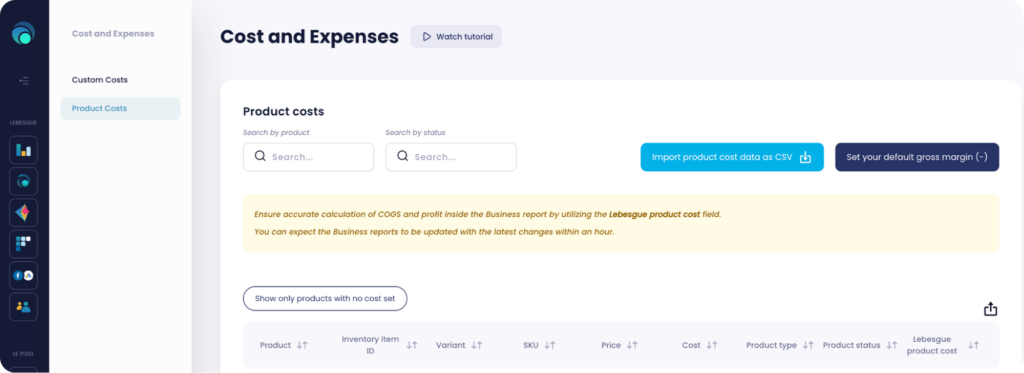
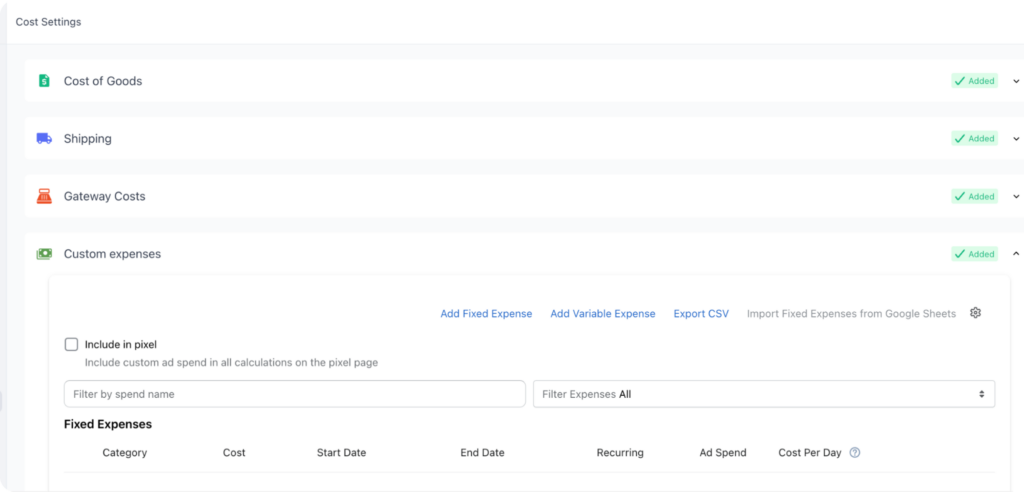
Attribution & accuracy
Lebesgue’s attribution combines pixel, server-side events, and machine learning modeling. It aims to predict missing conversions more accurately — especially important with iOS 17 privacy updates.
Triple Whale’s MTA is more straightforward: it follows Shopify events and aligns them with ad clicks. Simpler, but less adaptive.
Creative analytics
Lebesgue’s “Creative Angles” gives marketers data-driven creative insights — showing which hooks, visuals, or concepts drive higher ROAS.
Competitor insights
This is Lebesgue’s signature advantage. You can benchmark your ads, CPCs, CPMs, and creatives against top competitors in your niche. In addition, you can see any Facebook ad, Google ad or email your competitor has sent — data that Triple Whale doesn’t offer. It enhances overall understanding of your marketing and further improves insights.
Product journeys
Triple Whale offers one unique capability Lebesgue doesn’t currently replicate: Product journeys.
This feature allows merchants to map how customers interact with individual products over time, adding valuable context for retention and product-level strategy.
Ease of use
There are lots of reviews on Capterra and G2 noting Lebesgue’s more intuitive, cleaner, and simpler UX. Both Triple Whale and Lebesgue provide strong analytical depth.
Lebesgue can appear heavier at first, but it offers guided recommendations and visual summaries that simplify complex data.
When Lebesgue Fits Best
- Brands advertising on multiple channels (Meta, Google, TikTok, Amazon).
- Marketers who want predictive insights (“when to scale up or down”).
- Teams focused on understanding competitors and creative performance.
- Shopify-only DTC brands that prioritize simplicity.
- Founders who need at-a-glance dashboards with LTV and profit metrics
When Triple Whale Fits Best
- Enterprise or data-mature teams using analytics to drive strategic decisions.
- Agencies managing multiple Shopify clients.
- Teams without in-house analysts who prefer plug-and-play reporting.
Lebesgue vs. Triple Whale: Pricing Comparison
Pricing should be clear and predictable.
One of the biggest differences between Lebesgue and Triple Whale lies in how each structures pricing — and how much value you get for what you pay.
While Triple Whale uses a GMV-based tiered model that scales quickly with revenue, Lebesgue offers a flat, transparent model that stays accessible even as your store grows. In most cases, brands find they can get around 90% of Triple Whale’s functionality for roughly 50% of the cost
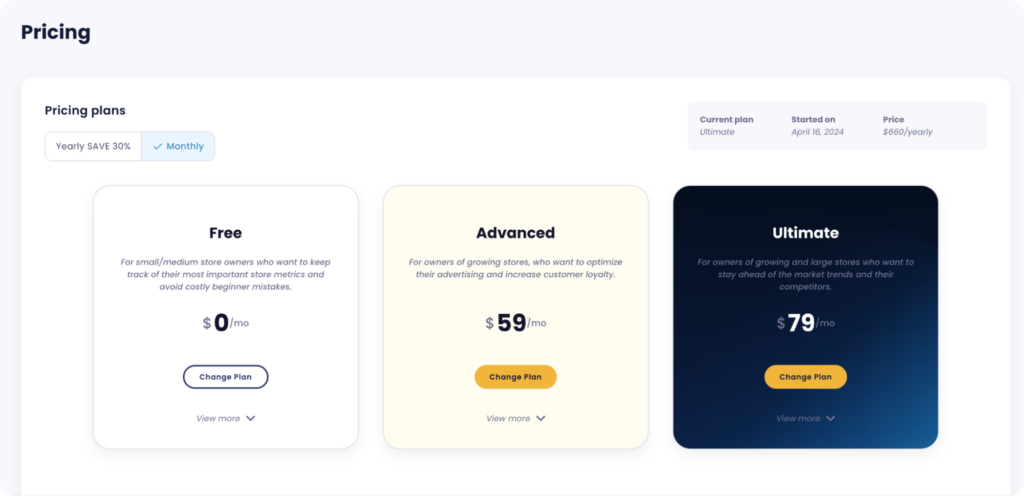
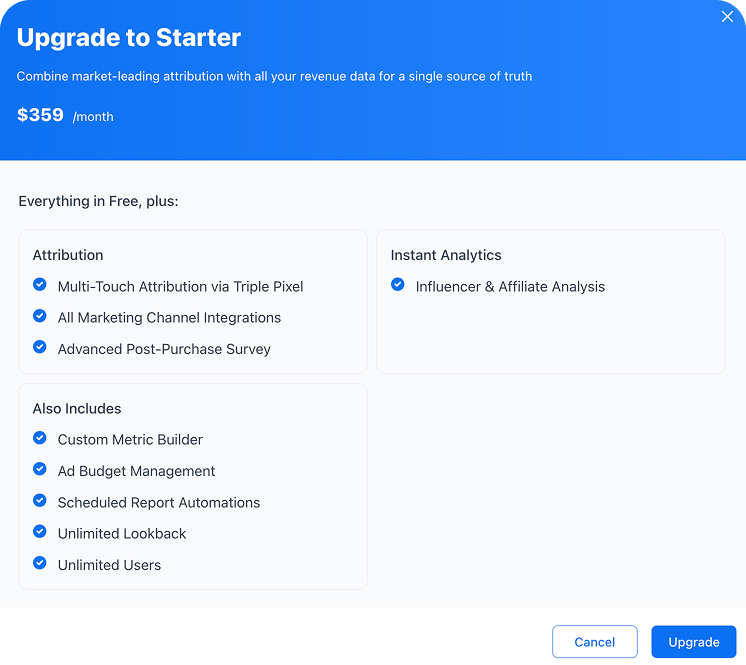
Lebesgue Pricing
Lebesgue’s pricing is built to be simple, predictable, and fair across every revenue band.
| Plan | Details |
|---|---|
| Free Plan | ✅ Full dashboard access, no lookback limits. |
| $79/month | ✅ Unlocks all app features, including competitor and creative analytics. |
Pricing scales by yearly revenue.
| Yearly Revenue | Price |
|---|---|
| < $250K | $99 |
| $250K – $500K | $149 |
| $500K – $1M | $219 |
| $1M – $1.5M | $249 |
| $1.5M – $2.5M | $289 |
| $2.5M – $5M | $499 |
| $5M – $10M | $749 |
| $10M – $15M | $999 |
| $15M + | $1,499 |
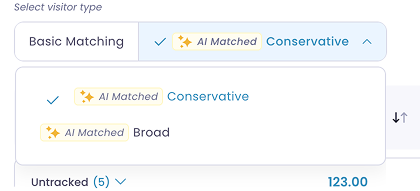
Even for 7- and 8-figure brands, Lebesgue’s complete analytics stack — including the pixel, competitor benchmarking, and creative insights — typically costs 50–60% less than comparable Triple Whale tiers.
Triple Whale Pricing
| Annual GMV | Free | Starter | Advanced | Professional |
|---|---|---|---|---|
| < $250K | $0 | $149 | $219 | $449 |
| $250K – $500K | $0 | $199 | $329 | $549 |
| $500K – $1M | $0 | $299 | $429 | $679 |
| $1M – $1.5M | $0 | $429 | $549 | $799 |
| $1.5M – $2.5M | $0 | $429 | $549 | $799 |
| $2.5M – $5M | $0 | $699 | $799 | $999 |
| $5M – $7.5M | $0 | $899 | $1,129 | $1,399 |
| $7.5M – $10M | $0 | $1,219 | $1,529 | $1,799 |
| $10M – $15M | $0 | $1,479 | $1,849 | $2,149 |
| $15M – $20M | $0 | $1,999 | $2,529 | $2,899 |
| $20M + | $0 | $2,449 | $3,079 | $3,549 |
Triple Whale’s pricing grows rapidly as GMV increases, with mid-market brands often paying $400–$800/month and larger brands well above $1,000/month for advanced attribution and dashboards. In comparison, those same brands can get everything—except Le Pixel—for $79 with Lebesgue.
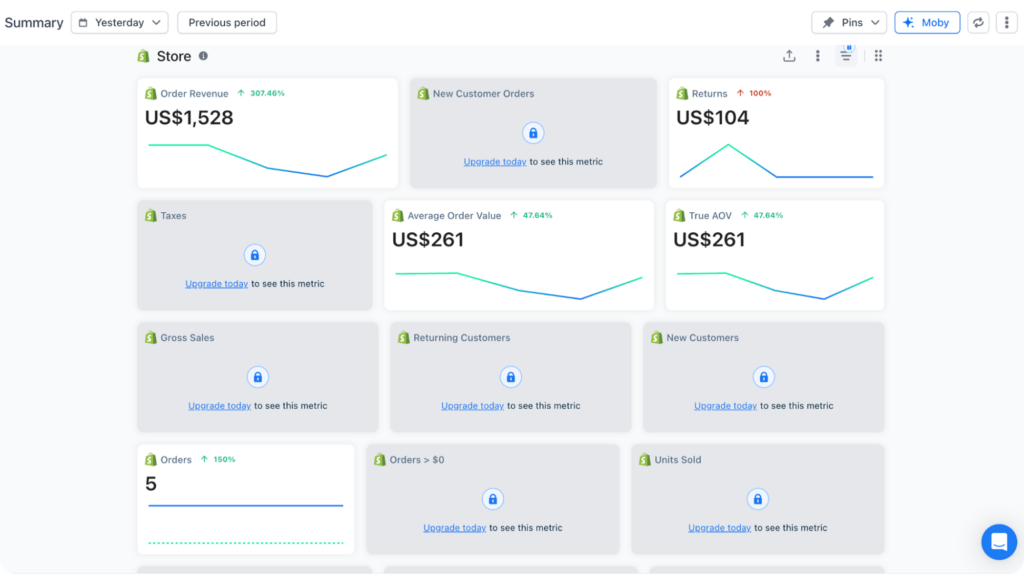
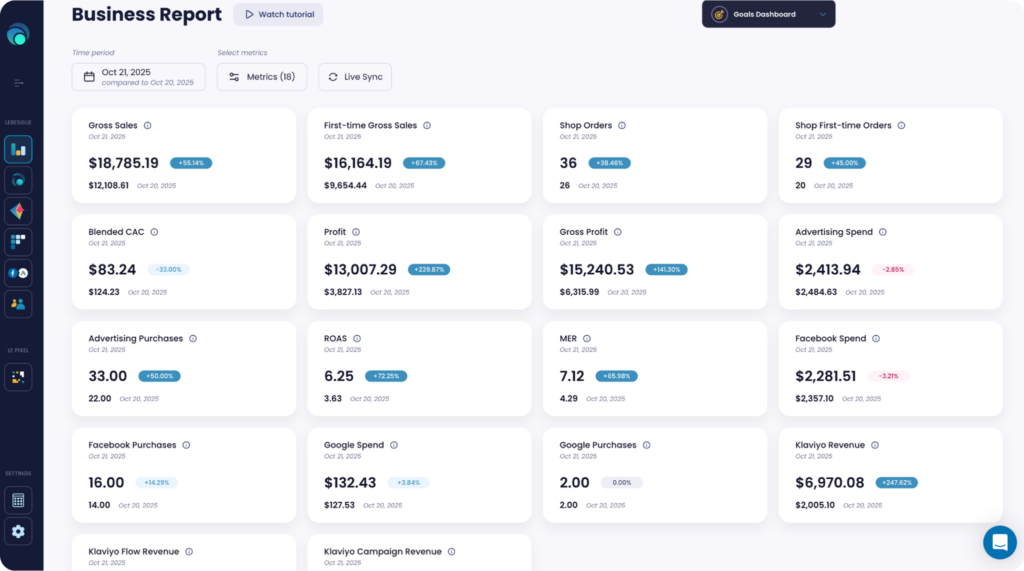
Add-Ons & Total Cost Comparison
When comparing the two platforms, it’s important to look beyond base pricing — especially at the add-ons and features that unlock full functionality.
| Add-On | Description | Monthly Cost |
|---|---|---|
| AI Agent (Henri AI) | Included in the standard $79/month plan | Included |
| Server-Side Tracking & Attribution | Included in the Pixel plan (for a $4M/year store, ≈ $149/month) | Included |
| Marketing Mix Modeling (MMM) | Built into the Pixel plan at no extra cost | Included |
| Add-On | Description | Monthly Cost |
|---|---|---|
Data Warehouse Sync |
Enables data export and advanced warehousing (not available with Lebesgue) |
$599 |
AI Agent (Moby) |
Available starting from the $250/month tier on top of the Starter plan |
$250 + |
Conversion & Retention Add-Ons |
Expands post-purchase data collection and retention modeling |
$59 + $155 + $359 |
Unlimited Measurement (MMM) |
Model-based media mix analysis |
$4,800 |
Example Total Cost – $4M GMV Store
| Category | Lebesgue | Triple Whale |
|---|---|---|
| Analytics, LTV, AI Intelligence | $79 | $599 |
| Data Enrichment, Server-Side Tracking & Attribution | $228 (Pixel included) | $813 |
| Marketing Mix Modeling (MMM) | Included ($228 total) | $4,800 |
| Estimated Monthly Total | ≈ $228 | ≈ $5,613 |
Even accounting for Triple Whale’s additional integrations (like data warehousing), the difference in total monthly cost is substantial — often 20–25× lower for a similarly sized store using Lebesgue, with core analytics, AI insights, and attribution included.
Triple Whale offers more enterprise-style modularity, but each layer adds substantial cost.
Lebesgue focuses on accessibility and completeness, bundling attribution, predictive modeling, and AI insights into a single, straightforward plan.

Lebesgue vs. Triple Whale: Overall Value
When you consider the complete cost of ownership — including analytics, attribution, AI, and marketing mix modeling — the difference between Lebesgue and Triple Whale becomes substantial.
For most stores, Lebesgue delivers around 90% of the functionality used in Triple Whale at roughly 50% of the monthly cost.
For larger stores, where MMM and data enrichment become essential, the gap widens dramatically — often reaching 20× or more in savings.
- A $4M GMV store, for instance, would pay roughly $5,613/month with Triple Whale once MMM, AI agent, and attribution add-ons are included.
- That same store on Lebesgue would spend about $228/month, with all of those capabilities — first-party tracking, AI insights, MMM, and competitor intelligence — already included.
Triple Whale offers strong enterprise flexibility through optional add-ons like Data Warehouse Sync and post-purchase enrichment. But that modular model means essential analytics layers quickly stack up in cost.
Lebesgue, by contrast, takes an all-in-one approach: advanced attribution, predictive AI (Henri), and competitive intelligence are included from the start, under a single, transparent plan.
The result is a toolset that’s more accessible for small and mid-sized ecommerce teams, while still deep enough for experienced marketers and analysts.
Lebesgue vs. Triple Whale: AI Agents
Artificial intelligence now powers most e-commerce analytics platforms — but how each company uses it makes a major difference in the insights you get.
Both Henri AI (Lebesgue) and Moby (Triple Whale) aim to simplify data interpretation and help marketers make faster, smarter decisions. Yet, their focus and underlying models differ significantly.
Henri AI – Lebesgue’s Predictive Brain
Henri AI is built as an analyst-grade intelligence system — not just reading data, but understanding why performance changes.
It connects to Meta, Google, Klaviyo, Amazon, and Shopify, continuously learning how shifts in spend, creative type, or competitor activity affect results.
What makes Henri stand out:
- Predictive insights – Anticipates when conversion rates will rise or ROAS drops are likely.
- Creative understanding – Evaluates image and video performance, suggesting new testing angles.
- Benchmark reasoning – Compares your performance against competitors and explains why trends occur.
- Cross-channel modeling – Uses machine learning attribution to pinpoint which ads or keywords drive incremental sales.
Essentially, Henri acts as a data scientist and strategist in one — helping marketers move from reactive reporting to proactive growth planning.
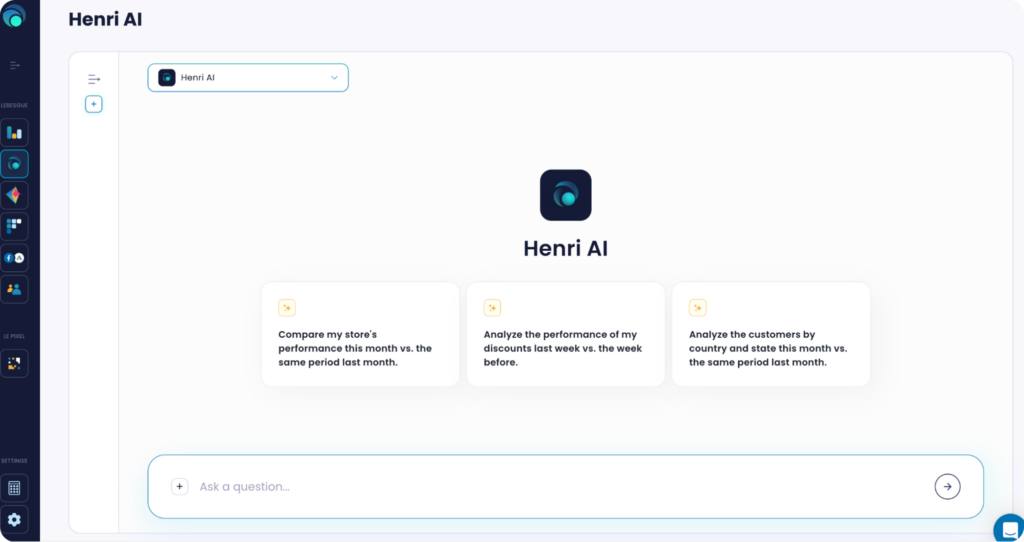
Moby – Triple Whale’s AI Assistant
Moby, Triple Whale’s AI system, focuses on simplifying reporting and insights inside the Shopify environment. It’s integrated into their dashboard to answer user questions conversationally and surface summary takeaways.
Its main strengths include:
- Conversational insights: Ask natural-language questions (“What was my best-performing ad set last week?”).
- Quick reporting: Generates summaries of key metrics for stores, campaigns, or channels.
- Operational assistance: Helps operators access data without needing to export or analyze manually.
Moby is ideal for founders or teams who want fast answers without deep technical interpretation. Its AI layer sits on top of Shopify and ad data, offering clarity rather than predictive foresight.
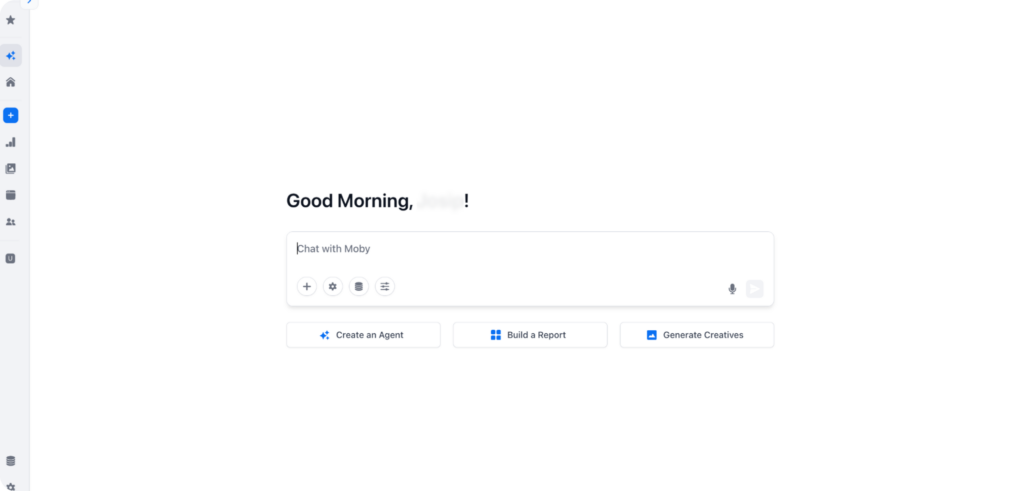
Key Difference in Approach
In essence, Henri AI is analytical and predictive, while Moby is conversational and descriptive.
- Henri helps you understand why performance changes — and what to do next.
- Moby helps you quickly see what happened and summarize results.
For data-driven marketers and analysts, Henri serves as an AI strategist. For founders who prefer simplicity and quick overviews, Moby serves as an AI assistant.
Both move the industry forward — but they reflect two distinct approaches to AI in ecommerce analytics:
- Lebesgue (Henri AI) → Deep modeling, competitive reasoning, actionable foresight.
- Triple Whale (Moby) → Conversational summaries, data accessibility, user-friendly insights.
Lebesgue vs. Triple Whale: Strengths & Limitations
Both tools bring real value to ecommerce teams — but they shine in different contexts.
Lebesgue delivers depth, predictive intelligence, and market insight across channels, while Triple Whale stands out for simplicity and operational ease within Shopify.
The tables below outline their key strengths and limitations side by side.
| Lebesgue | Triple Whale |
|---|---|
Advanced attribution modeling: Combines server-side + pixel tracking with game theory and machine learning. |
Shopify-first experience: Deep integration and real-time visibility across store metrics. |
Competitor & creative intelligence: View every Facebook, Google, and email campaign competitors launch. |
Multi-store management: Built for agencies handling multiple storefronts. |
AI-driven insights (Henri AI): Predictive, causality-based recommendations. |
User-friendly dashboards: Clean visualizations and quick setup. |
Transparent pricing: Flat, predictable model across revenue tiers. |
Post-purchase surveys: Zero-party data to enrich attribution. |
Cross-channel analytics: Unified view of Meta, Google, Amazon, Klaviyo, and TikTok. |
Real-time profitability: Clear store and profit tracking inside Shopify. |
| Lebesgue | Triple Whale |
|---|---|
Less emphasis on multi-store or agency-level dashboards. |
Limited competitor/creative analysis compared to Lebesgue. |
Can feel dense for beginners (guided insights ease onboarding). |
Several features locked behind higher-tier plans. |
Attribution less adaptive outside the Shopify ecosystem. |
Both platforms make strong cases — the difference lies in depth versus simplicity.
Lebesgue stands out for brands ready to scale intelligently. Its predictive modeling, AI insights, and competitor tracking create a clear understanding of why performance shifts — not just what changed.
Triple Whale, on the other hand, shines for Shopify-first operators and agencies managing multiple storefronts. It’s fast, intuitive, and provides a clean view of store performance, even if its analytics depth is lighter.
In short:
- Choose Lebesgue if you want advanced insight, AI guidance, and full marketing visibility.
- Choose Triple Whale if you prioritize ease of use and multi-store management.
Summing Up: Which One to Choose?
We still need to answer the question we asked at the start — which analytics platform is right for your store?
The truth is, it depends on what you value most.
If you want clarity, predictive insights, and a complete view across every marketing channel, Lebesgue is the better fit.
If you’re focused on simplicity, Shopify-native dashboards, and fast setup, Triple Whale will likely suit your workflow better.
| Scenario | Recommended Tool |
|---|---|
| Run ads across Meta, Google, TikTok, or Amazon | Lebesgue — unified data and predictive modeling clarify where to scale. |
| Rely on Shopify dashboards for quick financial overviews | Triple Whale — streamlined setup and strong profit-tracking. |
| Want to analyze competitors and creative performance | Lebesgue — deep ad, email, and creative intelligence. |
| Manage multiple Shopify stores or clients | Triple Whale — built-in multi-store dashboards. |
| Prefer AI-driven strategy and recommendations | Lebesgue (Henri AI) — predictive guidance and causal insights. |
Both Lebesgue and Triple Whale empower ecommerce brands to make smarter, data-driven decisions.
- Triple Whale simplifies data — turning analytics into quick, digestible dashboards.
- Lebesgue interprets data — uncovering why performance shifts, how competitors act, and what you should do next.
For most small-to-mid-sized brands, Lebesgue delivers roughly 90 % of Triple Whale’s functionality for about half the cost, while adding predictive intelligence, competitor intelligence, and market visibility that Triple Whale lacks.
If your goal is to understand not just what’s happening but why, Lebesgue is the smarter, more forward-looking choice.
Frequently Asked Questions about Lebesgue vs. Triple Whale
Yes. Lebesgue connects directly with Shopify, Meta, Google Ads, Klaviyo, Amazon, TikTok, and more — enabling unified cross-channel analytics.
Absolutely. Some brands use Triple Whale for operational dashboards and Lebesgue for advanced analytics, competitor tracking, and creative insights.
Both tools use advanced attribution methodologies, and in most cases, their reported results are comparable. Lebesgue’s hybrid model — combining server-side tracking, pixel data, and machine learning — delivers game-theory-based performance insights that help marketers understand why results shift. Triple Whale’s zero-party data tracking can reveal additional context around customer journeys, but it also inherits some of the inherent limitations of zero-party data, such as sample bias and lower event coverage.
Triple Whale offers more out-of-the-box multi-store management. Lebesgue focuses on deep performance insights for each brand.
Henri AI predicts and explains performance changes using causality-based reasoning, while Moby focuses on conversational summaries and quick data answers.
Triple Whale scales with GMV (starting around $149/month and rising steeply). Lebesgue has a free plan, $79 flat app plan, and revenue-based pixel pricing starting at $99 — usually 40–60 % less overall.



